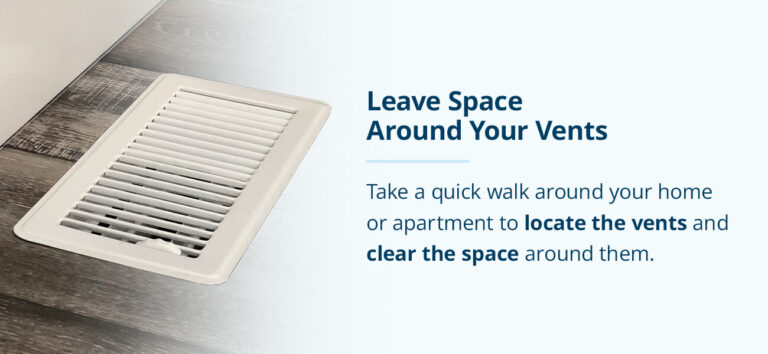
As the chilly winter months quickly approach, homeowners are starting to prepare to turn up the heat, sit by the fireplace and bundle up in their blankets. When you should turn your heat on depends on your location and the average temperatures in your area. If you’re thinking about cranking up the heat in your home, consider taking a few precautionary steps to make sure your living spaces are ready for the cold temperatures right around the corner.
When Should You Turn on the Heat in Your Home?
Take a look at the following tips to learn the steps you can take to warm your home for the winter:
When the indoor temperatures drop to 64 F or lower, you can turn on your heat to reach the average of 65-70 F in your home. Try not to set your thermostat above this range to make sure your family members or roommates can sleep at a comfortable temperature.
At What Temperature Outside Should I Turn My Heat On?
For the majority of Pennsylvanians, October is the first month of the year to hit 50-60 F temperatures. With this factor in mind, you can turn your heat on when October arrives or wait until your home’s thermostat reads anywhere from 64 F and below.
What Should the Indoor Temperature in Your Home Be?
Your indoor temperature and the cold air circulating your home are one of the best indicators for when you should turn your heat on. When fall approaches, make sure to regularly check the thermostat in your home to take notice of any temperature fluctuations.
The ideal temperature to set your home at is between 65-70 degrees Fahrenheit. Although this may look like a low number compared to how 65 F weather feels outside, this temperature range is perfect for sleeping comfortably and going about your day without feeling too warm or cold.
If you are ready to heat your home, take a look at your thermostat first and read below to see the next steps.
What to Do Before Turning on the Heat in Your Home?
While it may be tempting to turn the heat on early when you start to feel a crisp breeze in the fall, you should take a few steps to ensure your heating system is ready to warm your home. Follow these tips to make sure your home gets as much heat as possible this winter.
1. Check Your Furnace Filter
Your furnace provides heat to your home during the fall and winter months, while the air filter ensures the heater distributes clean air into your home. Before turning on your heat, locate your furnace and open the hatch. You should notice an airflow symbol that points in the direction of the furnace where the filter is so you can quickly locate and change the sheet.
Filters collect dust quickly, which can block a steady airflow from heating living spaces. To prepare for the winter months, make sure to check the heating, ventilation and air conditioning (HVAC) filters regularly and replace them every one to three months.

2. Leave Space Around Your Vents
You can let your furnace work its magic by making sure furniture and decorations are not blocking the airflow from vents. Take a quick walk around your home or apartment to locate the vents and clear the space around them.
You can even go the extra mile by placing rugs on your hardwood, tile or vinyl floors to trap the heat coming from your vents. This simple step will leave your room warmer and more comfortable as you enjoy cozying up with a good book and a warm cup of coffee.
3. Seal Your Doors and Windows
The easiest way to trap heat in your home is to seal the spaces in your doors and windows. The creases between the walls and these openings can let cold air inside that you might not notice until the indoor temperature drops below 60 F. You can prevent sudden air infiltrations by applying weatherstripping in the creases.
Luckily, weatherstripping is an easy process that leaves your home warm for months. You would only need to measure and apply the adhesive or vinyl material to the four gaps surrounding your door or window.
4. Do a Practice Run
After making sure your furnace is ready to heat your home, you can do a final practice run. Turn your heat on for about 10 minutes and note any strange noises from the furnace.
Loud noises can indicate a problem with your furnace’s features, such as a loose duct or blower fan, a cracked heat exchanger or a faulty ignition. A loud bang is normal when you first turn on your heat, but you should contact an HVAC professional to repair your furnace if you notice any other sounds.
You can also walk around your home and see if there are any cold areas. Some vents may look like they are producing heat. However, they could be experiencing blockages or closed dampers. Both issues are easily fixable by opening up the vents and clearing any debris blocking the air.
Using Heating Oil to Warm up Your Home
Now that you know what month and temperature to turn the heat on in your house, you can find more efficient ways to warm your living spaces. In recent years, homeowners have switched from gas-powered heating systems to heating oils. This alternative is energy efficient and doesn’t cause your heating bills to rise in the winter.
You can use heating oil in water-based heating systems, including a furnace or boiler. Both options use modern heat exchangers to reduce heat loss so you can enjoy a reliable source of warm temperatures when you need it most. With the help of heating oil, you can enjoy the constant warmth in your home from a source that produces more energy than propane and natural gas.
Heat Your Home With Marsteller Oil
If you need help heating your home in the chilly winter months, Marstellar Oil can help! We offer heating oil to homes in Central PA with the promise of quick deliveries, low prices and an easy ordering process.
When you need to warm up your home in the fall and winter months, you can trust Mastellar Oil to find you the best prices on heating oil. You can also enjoy auto-refills on your orders to have consistent and comfortable temperatures year-round.
Order your heating oil online today or contact us for a quote.



